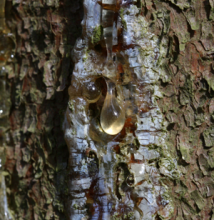Article
Resin is a liquid hydrocarbon secreted by some plants as a form of protection. If the plant is damaged, resin seeps from the wound, hardening as it dries into a protective layer. Natural resin can be harvested sustainably from trees, after which it is rendered into a variety of substances such as varnishes, glues, perfumes, and incense.
Dried resin, known as rosin, in a powdered form is used to increase friction between surfaces, such as between a bow and the strings of an instrument, or the hands of gymnasts and rockclimbers and the surfaces with which they engage. Rosin, which is also known as colophony, is a man-made substance that is produced by distilling the liquid resin until it condenses and solidifies. The final product can range in color; it is usually yellow or orange, but can be almost white or, alternately, close to black. While rosin is solid at room temperature, it melts easily and is used as an ingredient in a variety of products such as soaps, varnishes, adhesives, and sealing materials.
In Tony Hillerman's 1980 Navajo detective novel PEOPLE OF DARKNESS, rosin is mentioned in a natural setting, and probably refers to hardened resin rather than the chemically-produced substance.
"Spruce resin, March 11, 2012" by S. Rae is licensed under CC BY.
Manuscripts
References
Encyclopædia Britannica Online
N.d. resin. http://www.britannica.com/EBchecked/topic/499227/resin,
accessed September 15, 2014.
Encyclopedia Britannica Online
N.d. Rosin. http://www.britannica.com/technology/rosin, accessed June 18, 2015.

